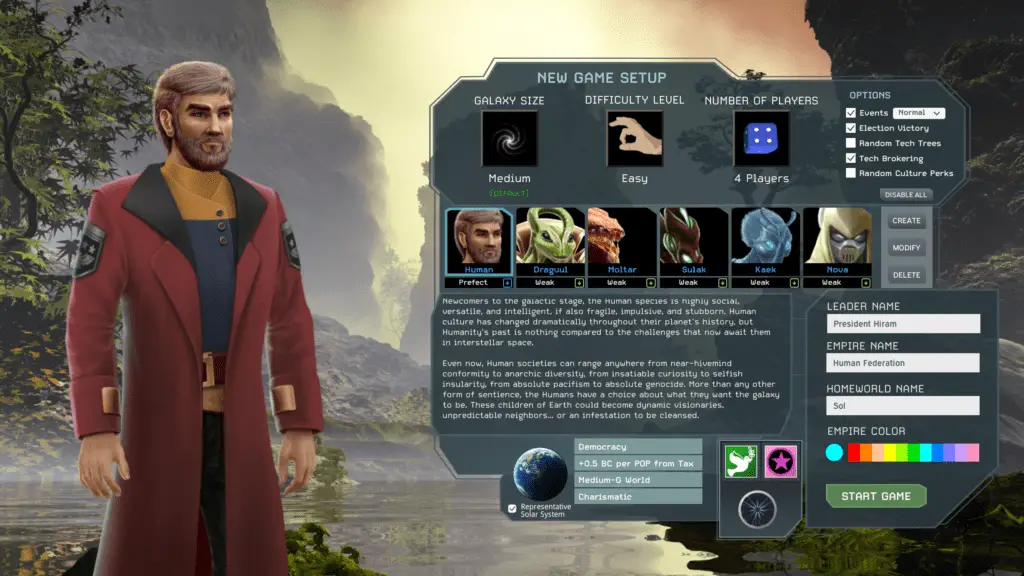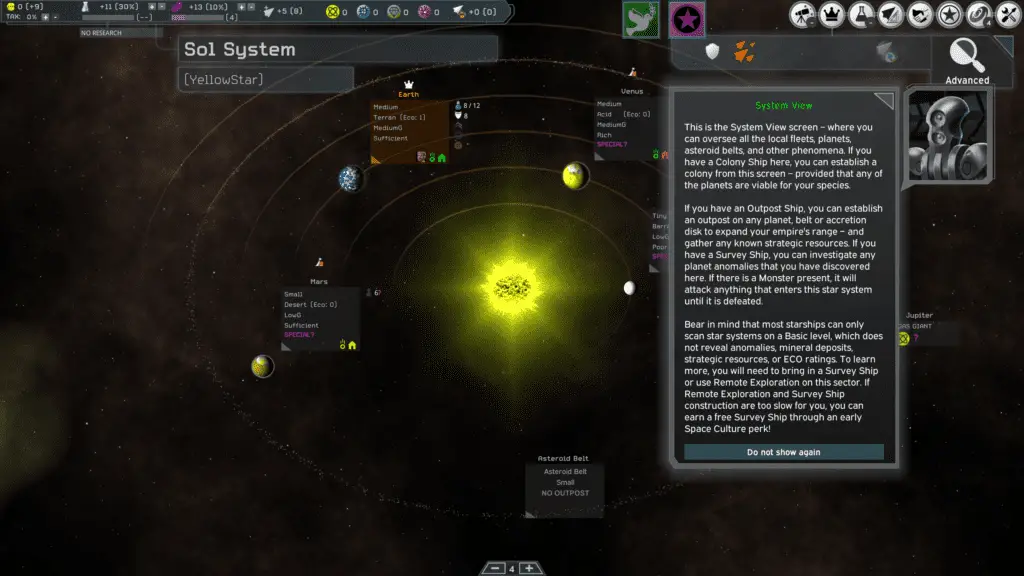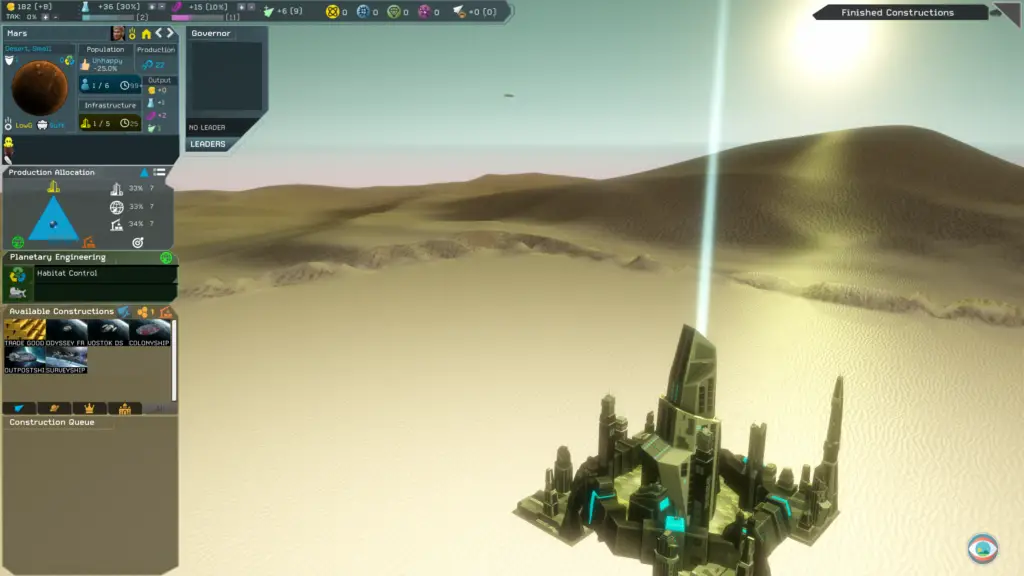Let me preface this by saying I’m not exactly an authority on strategy games. Small scale strategy games, like the Dawn of War, I have an easier time with. This is not that game. Interstellar Space: Genesis has the player growing an empire of intergalactic proportions from a single homeworld. So strap in and get ready to blast off to unknown worlds as I take a look at this grand scale indie game from Praxis Games.

The Aesthetic
I’ll begin with the aesthetics. It oozes classic sci-fi, from the humans to the aliens and beyond, this game looks like something out of Star Trek. Immediately you’ll notice that many of the art assets have an interesting “almost 3D but actually 2D” appearance that looks like it was painted. Creature icons are comprised of intricately detailed sprites, while environments and starships are 3D assets. It’s an interesting blend that comes together quite well. And the soundtrack, oh the soundtrack. Totally retro sci-fi. It’s full of grand, sweeping orchestral music that conjures fantastical images of life among the stars.
When you load up the game for the first time, you are greeted by a setup screen that allows you to choose your difficulty, starting advantages, galaxy size, player number (or rather, faction number as it adjusts the number of AI factions you will encounter), and individual difficulty adjustment for each race in the game. An easier start grants advantages, and harder starts will either have you begin on neutral footing, or make you a target for every living thing in the galaxy. Once you have decided how you want to begin, it’s off to the races.

You begin in an overview screen that shows the breadth of nearby explorable sectors and has your starting system marked with a circle indicating the range of control. Several bars and icons flank this view, showing resources, research, etc. The tutorial is extremely minimal, and at some times I found the game overwhelming as I attempted to grasp the concepts of expanding my human empire beyond Earth. Perhaps someone with more experience with civilization building games would feel more at home here, hard to say. Clicking your system gives you a zoomed in look at that sector, in this case our solar system. Mousing over nearby planets displayed their capacity for colonies and what was required to colonize them. As the first real form of direction I encountered, I decided my goal would be to colonize Mars.
Let’s Get ‘Splorin
I popped into the research menu, was again greeted by a very bare-bones tutorial, and perused the categories in an attempt to figure out what would help me reach Mars. I settled on the “Planet Engineering” category and began researching both Swamp Colonization and Desert Colonization, hoping that Desert would be the next step. As my research sat in the progress bar, I popped over to Earth and was met with the Colony Development screen. This tutorial was a bit more in-depth, and it wasn’t long before I figured out how to begin producing a new colony ship, which would of course be the start of my colony on Mars.

As I zoomed out of my system and began advancing the turns to get my research going, I received a notification that my empire had leveled up. I then had to choose new perks from several trees that would assist me as I expanded into the stars. I decided to begin with the Adventure tree, and went for a perk that gave my colonists interstellar fervor for adventure and would immediately grant me a brand new colony ship to fly off to a new planet. This was perfect because the one I was building back on Earth was going to take awhile. I closed this menu and began advancing the turns again until eventually my Desert Colonization was complete.
Along the way, my empire apparently made a new discovery in the form of Helium-3, a nuclear material that I could use for either Industrial Fusion or Military Fusion. I chose Industrial because I felt until I had a better handle on the game, I wasn’t in the market to make any enemies. After selecting my path, I zoomed in on Mars and it was time to start a colony. My new ship entered the atmosphere, touched down, and a brand new settlement sprang up and it was time to begin the cycle again.

The Final Frontier
Interstellar Space: Genesis is one of those games that knows exactly the kind of consumer it wants to draw in. This game is after the Civilization players, the Sim City players, the kind of gamer that loves building up from dust and rock to galactic empire. Was this game for me? I’m not really sure, I’ll probably come back to it and see how much farther I can get, but from my first impressions, the game is a little tough to grasp for someone who is unfamiliar with the genre. That’s not to scare you away from getting the game if you’re intrigued, I think the potential is there and that with some practice, it can be a rewarding experience. I certainly felt a rush as that colony ship touched down on Mars. My thought is that the game is complicated, but in the best way possible. The control over your empire is on a granular scale, and it feels like a real brain teaser to manage everything.
So if you’re someone who wants to hop into something a bit more challenging and really give your brain something to chomp on, Interstellar Space: Genesis might be right up your alley. And if you’re someone who is already familiar with the society building genre, you can’t go wrong here. Check it out on their Steam store page here or on their website here. As for myself, I think I’ll return to the stars and see what else awaits me on Mars and beyond.
[rwp_box id=”0″]
Images via Praxis Games

